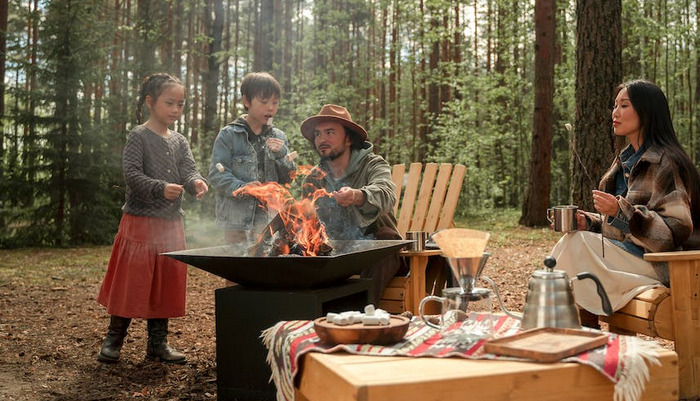A Handy and Helpful Guide to Cooking While Camping
Discover the ultimate guide for cooking while camping. Get handy tips and helpful techniques to create delicious meals in the great outdoors.
Picture this: you’re out in the wilderness; surrounded by towering trees, chirping birds, and crisp fresh air. You’ve got your gear, your hiking boots, and a couple of friends or family members.
Life couldn’t be more perfect! Except, there’s just one tiny problem… you’re feeling light-headed, and your stomach is growling. You’re all hungry, but what will you eat? The struggle of cooking while camping can be real if you don’t come prepared.
That’s where we come in! At HealthyWorthy, we understand that good food is important for any outdoor adventure. Not only does it keep your body fueled and happy, but it can also enhance your overall experience.
Table of Contents
Cooking While Camping
After all, what’s better than gathering around a warm fire with your loved ones, sharing stories, and chowing down on delicious food? That’s why we’ve put together this handy and helpful guide to cooking while camping.
Inside, you’ll find everything you need to know about planning ahead, choosing the right equipment and cookware, prepping your food, cooking techniques, and taking care of the environment.
Trust us; this guide will transform your camping experience from a grumbling tummy nightmare to a scrumptious dream. So, whether you’re a seasoned outdoors person, or this is your first time, we’ve got you covered.

No longer will you have to suffer from bland, boring, or difficult-to-make meals. Instead, get ready to cook up a storm and taste the magic of the great outdoors!
Read Also: Where Do I Buy Mountaineering Gear?
Planning Ahead
Do you inquire about cooking while camping? Are you tired of eating burnt hotdogs and canned soup while camping? Well, fear not my fellow campers, for we have prepared a handy and helpful guide to make your camping cooking experience a delightful one.
Planning Ahead:
The first step to enjoying your meals while camping is to plan ahead. No, we’re not talking about meal prepping for the week, but just planning your meals for the duration of your camping trip.
By doing so, you can save a lot of time during the actual trip. Make sure to pack the right ingredients for the meals you plan. Use zip-lock bags to keep the dry and wet ingredients separate to avoid any leaks.
Freeze your meats ahead of time. This way, you can keep the meat for longer and not worry about it going bad quickly. Take fresh meat for the first day and frozen meat for the following days.
Don’t forget to bring aluminum foil, it’s a must-have for campsite cooking. It can keep food warm, cover food for later use, or provide a method of cooking over the open fire.
Equipment and Cookware:
While packing, make sure to bring only the cookware you plan to use. This will save space and time when it comes to mealtime.
We recommend bringing a cast iron skillet or Dutch oven as your go-to cookware. Cast iron is incredibly durable and versatile, so you can easily use one dish for all three meals. Test your camp stove before you leave to make sure it’s working fine.
Don’t forget to bring reliable and durable camp stoves such as the Pro 60X or the Pro 90X. Put everything you can into squeeze bottles to make cooking much easier.
Plus, if the bottle ever gets cold, you can simply place it in a pan of warm water. No squeeze bottles lying around the house? You can also use disposable water bottles instead. Don’t forget to bring heavy-duty aluminum bags too.
They’re great for quick and easy cooking, take almost no room at all, and allow you to mix your meat and vegetables together.
Prepping Food:
Prepping food at the campsite can be a pain. Doing all the work at home will save a huge amount of time and help avoid the mess at camp. Chop your meat and vegetables before you leave.
Chopped meat and vegetables should be stored in plastic bags as this will avoid contamination and keep your vegetables nice and dry. Coat the outside of pots and pans with dish soap before cooking- this helps immensely with clean up.
Keep food locked up, either keep food in a chuck box, high in a tree, or in your vehicle. This will protect you and your family, as well as the local wildlife.
By following these simple steps about cooking while camping, you can ensure a pleasant and stress-free camping cooking experience. Catch the second part of this guide, where we’ll discuss Cooking Techniques, and Environmental Care. Stay tuned!
Equipment and Cookware
For a successful camping trip and nice cooking while camping, it’s essential to have the right equipment and cookware. You don’t want to bring unnecessary items or forget essential tools at home.
Trust us, you won’t be able to “MacGyver” your way through mealtime without them. Here are some key points you need to keep in mind while packing.

First, bring only necessary cookware. It’s easy to get carried away with packing the kitchen sink, but you don’t want to take items you won’t end up using. To save space and effort, select cookware that is versatile and can be used to cook multiple dishes. For instance, a cast iron skillet or Dutch oven is an excellent investment that can be used for nearly everything, from frying eggs to baking bread.
Before you leave, make sure to test your camp stove. You don’t want to be caught in the wilds with faulty equipment that refuses to start. Double-check that your stove is clean and fuelled up with enough propane.
If you’re in the market for a new camp stove, check out the Pro 60X or 90X stoves that are fast and reliable. Another useful hack is to use squeeze bottles for condiments, oils, dressings, and other items.
This way, you won’t have to carry extra utensils or deal with spillage. Just make sure to store the squeeze bottles in a warm place so that the contents don’t freeze. Alternatively, disposable water bottles work fine too.
When it comes to cooking while camping and cooking bags, opt for heavy-duty aluminum bags. They take only a little space, allowing you to mix your meat and vegetables or cook a wholesome meal in a jiffy.
You can use them on a camp stove, oven or over an open fire, making them incredibly versatile.
And here’s the best part – cleaning up is a breeze! Last but not least, here’s a tip to make cleaning up even easier. Coat the outside of your pots and pans with dish soap before cooking. It sounds strange, but this thin layer of soap helps immensely with cleanup.
Any food on the outside of the pan will fall right off when you wash it. With these essential tips, you’ll be enjoying delicious food in the wilderness in no time!
Prepping Food As It Should Be
Cooking while camping can be a challenge, but with some preparation, it can be a breeze. Preparing food ahead of time is essential to make your trip go smoothly and ensure that you’re not stuck preparing food at the campsite.
Here are some key tips to help you prep food before leaving.
Chop ingredients before leaving.
Prepping food at the campsite can be a real hassle, so it’s best to do as much as you can before you leave home.
Make sure you slice and dice all the vegetables and meat you’ll need for your meals. You’ll appreciate this when you are out in the woods, hungry and tired, and don’t have to worry about all that prep work. Store ingredients properly.
Once you’ve chopped all your ingredients, make sure to store them properly.
Use sealable plastic bags to keep the chopped meat and vegetables dry and avoid contamination.
Keeping everything organized and tidy will make it easier to find what you need when it’s time to cook up a meal.
Coat the outside of pots and pans.
This might sound strange, but it helps a lot with clean-up.
When you coat the outside of your pots and pans with dish soap before cooking, any food on the outside simply falls right off when you wash it.
Make sure to apply a thin layer of soap on the pan’s outer surfaces you’ll not be cooking on- we don’t want your meals to taste soapy.
Keep food locked up. Keeping your food

Cooking Techniques
Cooking Techniques: Ah, the moment you’ve been waiting for. The actual cooking of the food.
While cooking while camping may seem like a daunting task, it’s not as hard as it seems. In fact, these simple techniques can help make your meals a success.
First and foremost, cover your food while cooking. No one wants flies or insects landing on their food. Covering your pots and pans not only keeps the bugs out but it also helps your meals cook faster.
Plus, it locks in all the flavors. Next, make use of the campfire for flavor. Cooking over an open flame brings out a distinct taste in your food. Plus, it’s a great way to get rid of unwanted scraps. Just toss them in the fire and watch them disappear.
Cleaning as you go is another essential technique. No one wants to deal with dirty dishes while on a camping trip. Cleaning as you go not only keeps your campsite clean, but it also saves time and hassle. Pack a washcloth and a small bottle of dish soap for this purpose.
Lastly as for cooking while camping, don’t forget to use heat to your advantage. Adjusting the heat on your camp stove or moving your pot around the fire is essential to getting the right temperature for your food.
Also, if you find that your food is cooking too quickly, simply remove it from the heat source for a few minutes and then continue cooking.
So, there you have it. Follow these simple techniques, and you’ll cook up a storm in no time. Just remember, keep it simple, keep it delicious, and enjoy your camping trip.
Environmental Care
Environmental Care: As responsible campers, it is our duty to protect the natural surroundings that we have the privilege to explore.
Dispose of waste properly and keep the campsite clean to minimize your impact on the environment. Always bring trash bags and pack out everything you bring in. Don’t burn your trash, as it can start a forest fire.
Use designated fire pits and keep the fire small. If the site doesn’t provide firewood, gather dead wood lying on the ground away from the campsite. Don’t cut down living trees. When washing dishes and utensils, dump the dirty water and food scraps at least 200 feet away from any water source.
Use biodegradable soap to reduce water pollution. Leave the campsite cleaner than you found it and inspire others to do the same.
Remember, taking care of the environment is everyone’s responsibility. Let’s do our part and leave the area untouched and pristine for future generations to come.
Conclusion
So there you have it, folks – our handy and helpful guide to cooking while camping. We hope that by following these tips, you’ll be able to take your camping meals to the next level.
Remember to plan ahead, pack smart, and use the right equipment and cookware. Prepping your food at home and keeping it locked up will save time and keep you and your meals safe from animals.
And when it comes to cooking, cover your food, use the campfire for flavor, and clean as you go. Last but not least, don’t forget to dispose of your waste properly and keep your campsite clean. The great outdoors is not your personal dumpster, after all.
So get out there and enjoy the beauty of nature without sacrificing good food. Oh, and if all else fails, there’s always trail mix. Happy camping!




